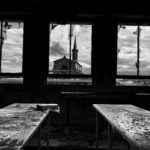This story begins with two photographers: the first one, Christian, a Frenchman living in Arcachon, a little town on the Ocean, 70 km away from Bordeaux. The second one, Valeria, an Italian living in Milan.
They have met by chance in the virtual land of an app called Instagram in 2013, and for the last four years they have been sharing their thoughts about photography through two other apps called Viber and Kik. They have never met in the real world until now, though they have been planning to do that sooner or later. As they share not only a love for photography but also the fact they don’t like talking about their personal work, they have decided to write about one another. This is the first of two articles reassuming a relationship based on reciprocal admiration and a long conversation about the need for photography.
(Within dance the expression pas de deux refers to the number of dancers, men and/or women, performing together a sequence of a ballet or choreography.)
**********
I was a very “young” Instagramer with no awareness of my own work when I first came across Christian Mondot’s photography in 2013. I was making my first steps in the jungle of Instagram when I found his striking bw account (@cclm31) and I was caught off guard by all those images speaking so honestly of their author’s emotional side. It was more or less like when a child perceives the difference between himself and an adult, feeling the shape of authority. Compared to mine, his gallery had no contradictions or random images, but showed a definite strong identity. The most impressive trait to me was that all the images seemed related to one another, like words of a speech, and they were meaningful and soulful despite the absence of a garish subject.
I was in awe of his skillfulness in focusing on humble details, like an old washtub, a newspaper in an abandoned classroom, a closed door.
His extraordinary way of shooting the ordinary showed a contemplative eye to the world and spoke a language full of intimacy to my heart.
I realized in my naive approach to his photography how intensity doesn’t need spectacularity or drama, but rather a moved eye, and how the importance of a subject comes from the story the photographer sees or imagines behind it. Everything can become important when beautifully focused and framed, but it’s not just a matter of technical skill. The impact was strong but it took me a long period of time and more personal consciousness about photography to unfold the mystery and to understand the message hidden behind that work.
Preferred subjects to talk of his inner world are people and nature. Many of Christian Mondot’s photographs don’t feature visible people but rather their absence: melancholic shots like those of abandoned places full of traces left by their passage, empty restaurants frozen in the wait of customers, interiors of churches in the half light without believers.
Sometimes we get the human presence from a sign, like the light coming from a window, or a dog waiting for its master. Through this feel of missing people, Chris seems to talk of a lost Golden Era, full of warm relationships and expectations, like youth is.
These images without people and missing people are gloomy, and fascinate the observer with their ominous power: the unpleasant loss of the Golden Era is unavoidable. In more recent images, the presence of people seems rather to emphasize the serene acceptance of the loneliness of the human condition. Chris shows himself like a lone wolf, bashful and contemplative, loving his rich and multifaceted microcosm.
Nature is his best friend. Chris said to me he often gets lost in the beauty of landscapes, standing alone and totally overcome by the feel of immensity, absorbing the space around him in an impossible desire of symbiosis and waiting until he understands how to take “that” shot. Nature looks like Mother: peaceful, embracing and supportive. This side of Chris’s work suggests a powerful identity with mystical traits.
He is a professional musician, and music never leaves him alone as it is always in his head like a soundtrack. That’s why looking at his photos featuring awesome countrysides or marvelous sea landscapes, I have often sensed a sound, like a whisper, growing until it becomes the din of an orchestra tuning its instruments.
Chris uses a poetic black and white language to tell an endless series of little stories. He has a very personal use of black and white: his black is deep and enveloping, often taking most of the image, sometimes soft like velvet, others very intense and dramatic. Inside it, smooth like a caress or sharp like a blade, the light insinuates itself, showing beauty. He uses his whites coming out of all those blacks like a curtain raised to reveal the truth. It’s a mystical light and I have often felt in awe of his way of engrossing the observer: ravished and sucked inside the frame, we are called to take part.
Christian Mondot’s photography fulfils its author’s wish to engross the observer in his own emotions. These are artistic photographs, evoking much more than they show, involving more than what they feature.
There’s no way to escape a personal participation in these charming stories, so be ready and enjoy them.
You can find Chris on: Instagram | Website
About Author

- Since her childhood Valeria has been a storyteller: She used to invent musicals for puppets. Her parents would tease her as they perceived she magnified reality. What she liked was not to hide the truth but rather, to give more drama or beauty to the ordinary facts of her life. She wasn’t particularly fond of photography until October of 2013, when she created an account @_soulkitchen_ on Instagram, starting a diary of images. She is a contemplative, not interested in representing reality, but rather memories, desires, and the core of feminine beauty. If something captures her attention, or if she has an idea about, a story to tell, she immediately thinks of how to shift it from her imagination to an image.
Latest stories
 StoriesJuly 31, 2017Pas de deux, part 1
StoriesJuly 31, 2017Pas de deux, part 1 StoriesJuly 24, 2016Keep it Simple: an interview with Nei Cruz
StoriesJuly 24, 2016Keep it Simple: an interview with Nei Cruz StoriesApril 8, 2016Solitude in Peace: This is @__circo
StoriesApril 8, 2016Solitude in Peace: This is @__circo StoriesNovember 4, 2015Barbie’s secret life
StoriesNovember 4, 2015Barbie’s secret life

















This is so beyond wonderful, beyond beautiful. I’m at a loss, for the moment, for more words.
Heartfelt thanks dear Caren , delighted you like this article !
Val, this is a such a beautiful piece of writing, a piece of art in itself . You have managed to capture so many details about Chris’ work. I used to follow Chris a long time ago but through changing accounts and countries, I lost touch with his work. Kindest thanks for reintroducing him
Thank you Fiona , glad you got in touch with him again !